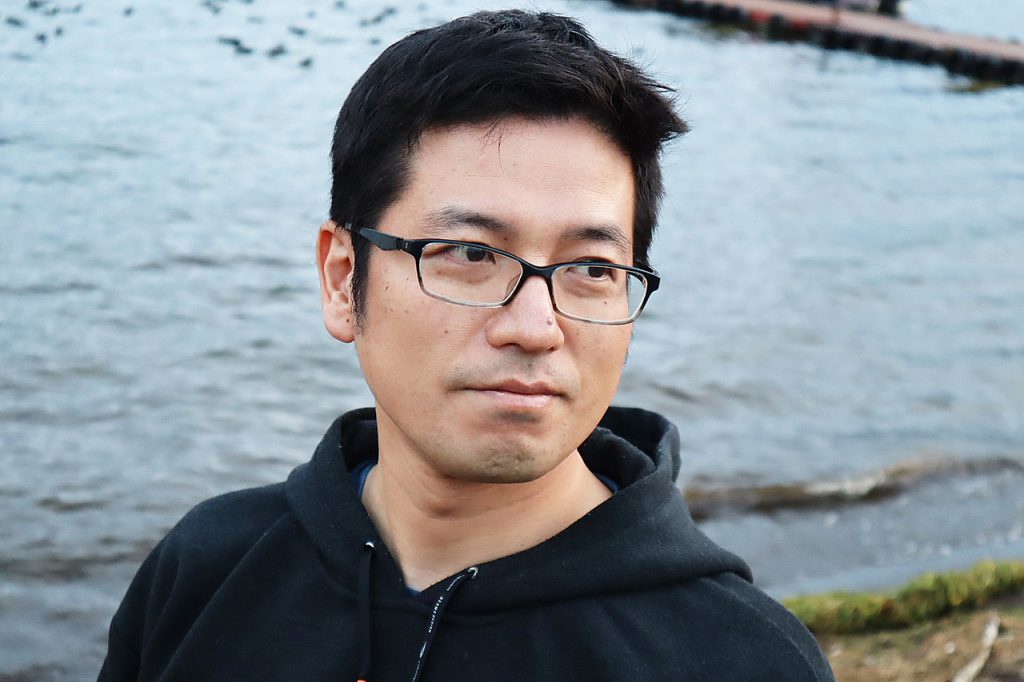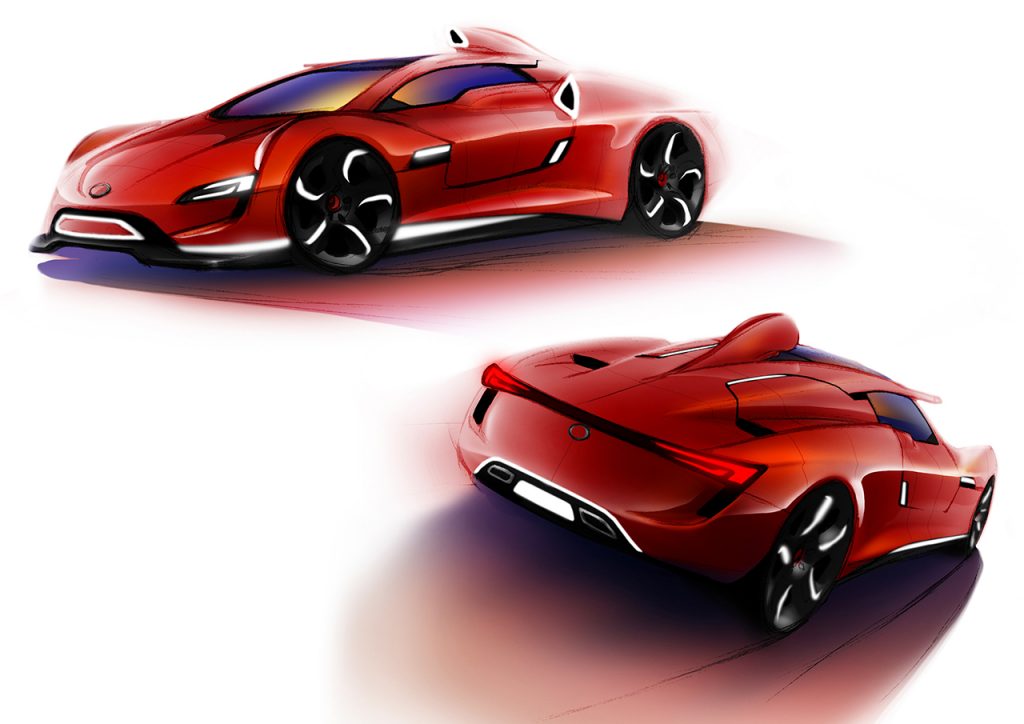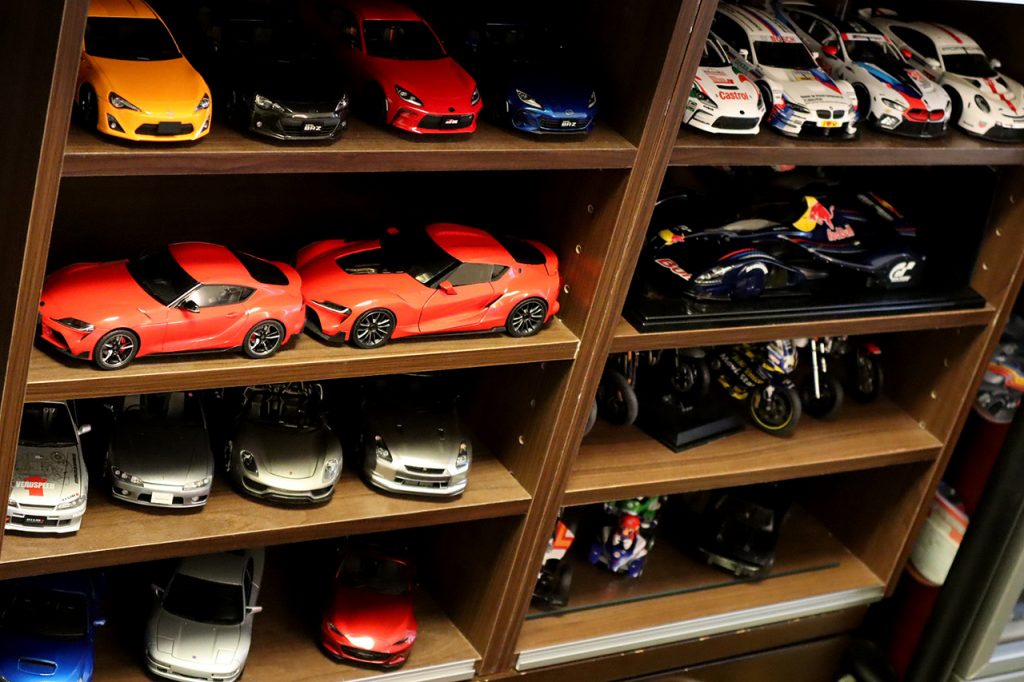This episode features a talk with Art Director Shunsuke Otsuka. He’s established a niche for himself to the point where he’s known internally as the “car person” . We picked his brain about how to broaden your own niche, as well as what you can do to let others know what you’re good at.
Otsuka-san also mentions that communicating with drawings is not only useful for artists, but for people in other occupations as well. What can you do by communicating with drawings? Read on to find out!

Shunsuke Otsuka, Art Director
Affiliation: Studio 2 Group 2 Production 5 Art Section
―――Could you briefly tell us about your department and what you do for work?
I’m an Art Director under Production 5 of Studio 2’s Group 2. Art creation can be further broken down into parts like artists for environments, characters, robots, and more, but I supervise the overall process. I give advice and think about what approaches or methods we can take to create high-quality data for the deliverables that get shown to me.
――― Looks like your work covers many subjects.
Yes. I learn whatever information I need for a particular task, and I proactively study the topic if my team or I need to know more. I create opportunities for team members to “level up” their knowledge, and we sometimes look at reference material together. I spend more of my time now doing this kind of work compared to when I was just a designer working on my own tasks.
For example, “work” for me can have me working on a title that allows creative freedom on a large number of things, or it can be a title where I have to work within the general restraints of what’s already been established. When someone new joins the project, I have to act as a sort of translator, telling them what style of design the project wants, and the particular title’s values.
――― So there’s a lot you have to do other than just producing art.
Right, and it isn’t all fun (laughs). I often find myself having to give the same explanation whenever a new member joins a team.
Fortunately, we now use Zoom so I can just tell everyone to join the meeting at a certain time, and we have screen share on while we explain things. It’s a nice tool, and it highlights one of the benefits of teleworking compared to having everyone go inside a physical meeting room.
――― Not to mention the effort it takes to book the room!
Not having to book a meeting room is another big benefit. Doing everything online means that we can easily create places where large numbers of people can gather at the same time.
――― You touched on the good parts of teleworking, but did you run into any issues?
The project I’ve been talking about also has a Director and Technical Director. We worked as a team and spent around two years trying solutions to fill holes in places that were prone to have inadequate communication.
We were thinking of ways to create small talk, and we tried things like putting team members in groups of three and setting aside an hour for chatting. It’s hard to ask what someone is doing when you’ve never worked with them before, despite being on the same project. So I try to build a team where everyone can easily ask each other for help.
――― You’re right, you don’t really know who somebody is if you’ve never worked with them before.
Yes, and there were even situations where people would go to the office for the first time in a while, and it’d be the first time they’ve met face-to-face, even though they’ve been working together for a whole year.
A lot of our communication is done on chat tools like Slack, but sometimes words aren’t enough, or what we say comes across ruder than what we intend…
So we tried having quick Zoom meetings to allow for people to see each other’s facial expressions while they communicate as well. It really emphasized how important face-to-face communication was, even online.
――― Talking directly to someone can change how the message is delivered too. Moving on, do you have any interesting stories from the work you’ve done in the past?
After I joined the company, I got to work on the development of Ridge Racer’s vehicle data for about 10 years. I liked cars and racing to begin with, and I started by creating the textures for the cars. I would gradually broaden my horizons to colors, meters, interiors, custom parts, and even car designing.
This lead to more people asking me to create data for cars in whatever project they were working on, and I became “Otsuka the car person”.
I also had the chance to design sections of a real-life custom car, where I got to experience working with someone I admired from the automobile industry!

A drawing for a racing game
――― Wow, I see that you’re really into cars! What was your point of entry into racing game development?
When the company was still called Namco, they had a posting for “racing game developer”, and I applied because I wanted to make a racing game. I got to work on nothing but racing games for the next 10 or so years, so I guess I was really fortunate (laughs). Of course, we ran into issues, but I liked the work, and I wasn’t against studying when I lacked knowledge or had to learn new things.
When I’m in charge of designing fashion items like shoes and casual clothes, or other non-car things, I would self-reflect on what I like about cars. I would then incorporate these elements, like choosing certain materials or how the clothes come together, into the design, adapting the skills I gained as a car lover (laughs).
――― Can I ask about your approach to content creation?
I think the best way is to actually have the physical object, and then analyze what’s good about it. Also, knowing where to go for information or what the fans are following. For example, you’ll always find something at an event or exhibition.
One thing that often happens when I look for information on cars is that the PR departments of automobile companies would release research papers or other documentation. This isn’t limited to cars, but if you look for information or research published by a company, it usually goes deep into detail. Magazines interviewing the people who created whatever you’re looking for are also good reads.
――― I see you’ve applied your love for cars to all kinds of things!
I guess so. Attention to detail goes into the things we make, so if you know what details to focus on, you can make something good even if you don’t like the particular subject.
To clarify, when trying to like something you didn’t like before, you’ll build an interest towards it, and knowing background information will make you like the thing more. At least that’s what I think.
Of course, there is the opinion that it’s faster to just ask someone who’s already a fan, instead of going through the process yourself.
Having someone knowledgeable teach you about something also presents opportunities to meet more people within the company. There’s no need to know everything about anything, but it’s important to know where to go and who to ask whenever you get stuck on something.
A variety of people work at Bandai Namco Studios, so you can probably find information about anything if you looked hard enough.
――― Right now, you’ve become “Otsuka the car person” at the office, but what should I do if I want people to be aware of what I’m good at?
In my case, a lot of it was because my manager and other people I worked with started telling other people I knew a lot about cars, so I have them to thank.
Having worked here for around 20 years, I can say that you can find work within the company if you make yourself known.

Otsuka-san’s personal car collection!
――― Do you have any personal rules you follow when working?
This one might be obvious, but I try to submit my ideas as a drawing as quickly as possible.
Of course, there are things I can’t draw and there are many other inhouse designers who are better than me in terms of skill and area of specialty. But when I’m communicating with planners and engineers, they see me as a designer, an art person.
By turning verbal communication into a visual medium, we can identify differences in our personal interpretations, and other people motivated by the drawing can communicate with their own art. I think this is the best part of making something as a team, and I’m most excited during these moments.
When we discuss what kind of project we’re going to be working on, the first bits of information I get are usually through conversation, maybe there will be a text document, or some reference images. During the meeting, phrases like “we want it to be cool” or “it should be set in the near future” will get used, but are still vague since everyone has different opinions on what is “cool” or different ideas as to what “near-future sci-fi” looks like.
So I try to prepare multiple drawings based on what is discussed, and ask for feedback. It doesn’t matter if it’s positive or negative, but whatever reaction they give usually helps facilitate discussions.
Regardless of the quality of the drawing, it creates a positive atmosphere since they’re usually surprised that I already have something to show them.
――― I guess getting to show things using art is a perk for designers. But still, it’d be nice if I could be as proactive as you.
This isn’t limited to designers; I think people from any discipline can make a difference if they can draw something on a sticky note or some scrap paper.
Instead of using just words to communicate something like “the character walks in from here and goes through there”, a simple doodle, like what you would draw in the margins of your notebook, will probably change the quality of communication you have with other people.
――― Is there anything you’re really confident in?
It would be “enjoying the creation process”. When developing a game, some things might not go well, or issues might arise. I enjoy the process of thinking about how I can “clear” these problems. Maybe I’m projecting my love for games into these situations.
No matter the project, there will always be times when things don’t go the way you want the first time, and that you’ll be frustrated at these things. I’ve often experienced it first-hand. But just being frustrated and complaining won’t make the problem go away, and it only makes everyone else feel bad. It’s best to focus on the positives in these situations.
That doesn’t mean ignoring the negatives, though. Rather, try to find the parts that can be enjoyed from them. This is something I’ve become more aware of now that I’m in a position where I can easily influence other people.
It’s easy to say but hard to execute. I always think of ways to try and make game creation fun, so I try to create an environment where everyone can enjoy developing games.
――― Are there other things you’d like to try or experiment with in the future?
I normally work on things you see on-screen, so I’d like to try making something that goes beyond the boundaries of the screen. Toys, accessories, or some experience that links players to the game they played would be fun to make.
――― Do you have a guiding principle?
“You can only get good at something if you like it.” It’s what my dad told me when I was still in school and deeply into drawing, model building, and video games.
This not only applies to things I already like, but also for things that I didn’t know about and had to look up for work. The more I learn about it, the more I like it, and if I know what I like about it, I can focus on how I should go about relaying that to other people. I feel that game development presents me with these opportunities to learn every day.
――― Thank you!





